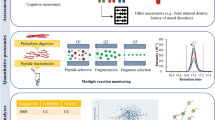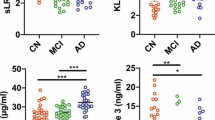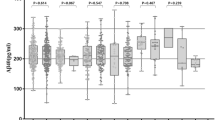Abstract
To explore plasma protein panels as potential biomarkers to screen for mild cognitive impairment (MCI) among elderly Chinese individuals with different educational backgrounds. Forty-four illiterate, 36 lower education (1–6 years), and 55 higher education (7 years or more) elderly individuals were included in the present study. Among all subjects, 67 were healthy individuals and 68 were diagnosed with MCI. Fifty plasma proteins in blood samples collected from these subjects were analyzed via the Luminex assay. Binary logistic regression was utilized to explore diagnostic models for MCI among the three educational subgroups. Then, receiver operating characteristic (ROC) curves were conducted for the clinical validity of the MCI models. Among the analyzed proteins, clusterin was used in the model of MCI among the total sample with a sensitivity (se) of 67.6%, a specificity (sp) of 59.7%, and a classification rate of 63.68%. The MCI model for the illiterate group included cystatin C, plasminogen activator inhibitor-1, and apolipoprotein A-I (se: 71.4%, sp.: 82.6%, accuracy: 77.25%). The sensitivity, specificity, and classification rate of the diagnostic model of MCI in elderly adults with lower education (human serum albumin) were each 75.0%. Additionally, the sensitivity, specificity, and accuracy rate of the diagnostic model for MCI elderly individuals with higher education (alpha-acid glycoprotein + soluble intercellular adhesion molecule-1 + pancreatic polypeptide) were 77.8%, 89.3%, and 83.60%, respectively. The performance of diagnostic models for MCI based on different educational levels is superior to that of diagnostic models for MCI without grouping by educational level.

Similar content being viewed by others
Data Availability
The data used in the present study are freely available upon reasonable request. When data have been shared, authors are required to include in their data availability statement a link to the repository they have used and to cite the data they have shared. If sharing data compromises ethical standards or legal requirements then authors are not expected to share it.
References
Ben-Hadj-Mohamed M, Khelil S, Ben Dbibis M, Khlifi L, Chahed H, Ferchichi S, Bouajina E, Miled A (2017) Hepatic proteins and inflammatory markers in rheumatoid arthritis patients. Iran J Public Health 46(8):1071–1078
Cherbuin N, Anstey KJ, Baune BT (2017) Oxidative stress, inflammation and mild cognitive impairment. European Psychiatry 41:S742–S742
Ezra A, Rabinovich-Nikitin I, Rabinovich-Toidman P, Solomon B (2016) Multifunctional effect of human serum albumin reduces Alzheimer’s disease related pathologies in the 3xTg mouse model. Journal Of Alzheimers Disease 50(1):175–188
Faria MC, Goncalves GS, Silveira JN, Carvalho MG (2013) Plasma levels of intercellular cell adhesion molecule-1 (sicam-1) in elderly with and without Alzheimer disease. J Thromb Haemost 11:493–494
Fiest KM, Roberts JI, Maxwell CJ, Hogan DB, Smith EE, Frolkis A, Cohen A, Kirk A, Pearson D, Pringsheim T, Venegas-Torres A, Jetté N (2016) The prevalence and incidence of dementia due to Alzheimer's disease: a systematic review and meta-analysis. Can J Neurol Sci 43:S51–S82
Folstein MF, Folstein SE, McHugh PR (1975) “Mini-mental state”. A practical method for grading the cognitive state of patients for the clinician. J Psychiatr Res 12(3):189–198
Frisoni GB, Boccardi M, Barkhof F, Blennow K, Cappa S, Chiotis K, Démonet JF, Garibotto V, Giannakopoulos P, Gietl A, Hansson O, Herholz K, Jack CR Jr, Nobili F, Nordberg A, Snyder HM, ten Kate M, Varrone A, Albanese E, Becker S, Bossuyt P, Carrillo MC, Cerami C, Dubois B, Gallo V, Giacobini E, Gold G, Hurst S, Lönneborg A, Lovblad KO, Mattsson N, Molinuevo JL, Monsch AU, Mosimann U, Padovani A, Picco A, Porteri C, Ratib O, Saint-Aubert L, Scerri C, Scheltens P, Schott JM, Sonni I, Teipel S, Vineis P, Visser PJ, Yasui Y, Winblad B (2017) Strategic roadmap for an early diagnosis of Alzheimer’s disease based on biomarkers. Lancet Neurol 16(8):661–676
Ghidoni R, Benussi L, Glionna M, Desenzani S, Albertini V, Levy E, Emanuele E, Binetti G (2010) Plasma cystatin C and risk of developing Alzheimer’s disease in subjects with mild cognitive impairment. Journal Of Alzheimers Disease. 22(3):985–991
Gironi M, Borgiani B, Farina E, Mariani E, Cursano C, Alberoni M et al (2015) A global immune deficit in Alzheimer’s disease and mild cognitive impairment disclosed by a novel data mining process. Journal Of Alzheimers Disease. 43(4):1199–1213
Grontvedt GR, Schroder TN, Sando SB, White L, Brathen G, Doeller CF (2018) Alzheimer’s disease. Curr Biol 28(11):R645–R649
Hodson R (2018) Alzheimer’s disease. Nature. 559(7715):S1–S1
Hu WT, Holtzman DM, Fagan AM, Shaw LM, Perrin R, Arnold SE, Grossman M, Xiong C, Craig-Schapiro R, Clark CM, Pickering E, Kuhn M, Chen Y, van Deerlin VM, McCluskey L, Elman L, Karlawish J, Chen-Plotkin A, Hurtig HI, Siderowf A, Swenson F, Lee VMY, Morris JC, Trojanowski JQ, Soares H, For the Alzheimer's Disease Neuroimaging Initiative (2012) Plasma multianalyte profiling in mild cognitive impairment and Alzheimer disease. Neurology. 79(9):897–905
Hu C, Yu D, Sun X, Zhang M, Wang L, Qin H (2017) The prevalence and progression of mild cognitive impairment among clinic and community populations: a systematic review and meta-analysis. Int Psychogeriatr 29(10):1595–1608
Huang C-W, Tsai M-H, Chen N-C, Chen W-H, Lu Y-T, Lui C-C, Chang YT, Chang WN, Chang AYW, Chang CC (2015) Clinical significance of circulating vascular cell adhesion molecule-1 to white matter disintegrity in Alzheimer’s dementia. Thromb Haemost 114(6):1230–1240
Kang DW, Lim HK, Joo SH, Lee NR, Lee CU (2018) The association between hippocampal subfield volumes and education in cognitively normal older adults and amnestic mild cognitive impairment patients. Neuropsychiatr Dis Treat 14:143–152
King E, O'Brien J, Donaghy P, Williams-Gray CH, Lawson RA, Morris CM, Barnett N, Olsen K, Martin-Ruiz C, Burn D, Yarnall AJ, Taylor JP, Duncan G, Khoo TK, Thomas A (2019) Inflammation in mild cognitive impairment due to Parkinson’s disease, Lewy body disease, and Alzheimer’s disease. International Journal Of Geriatric Psychiatry 34(8):1244–1250
Liu HC, Hu CJ, Chang JG, Sung SM, Lee LS, Yuan RY, Leu SJ (2006) Proteomic identification of lower apolipoprotein A-I in Alzheimer’s disease. Dement Geriatr Cogn Disord 21(3):155–161
Liu S, Suzuki H, Ito H, Korenaga T, Akatsu H, Meno K et al (2019) Serum levels of proteins involved in amyloid-beta clearance are related to cognitive decline and neuroimaging changes in mild cognitive impairment. Alzheimer’s & dementia (Amsterdam, Netherlands) 11:85–97
Lowe D. (2019) Another Alzheimer’s antibody fails. There Will Be More https://blogs.sciencemag.org/pipeline/archives/2019/01/30/another-alzheimers-antibody-fails-there-will-be-more. Accessed January 30, 2019
Lu H, Wang XD, Shi ZH, Yue W, Zhang Y, Liu S et al (2019) Comparative analysis of cognitive impairment prevalence and its etiological subtypes in a rural area of northern China between 2010 and 2015. Sci Rep 9:7
Marksteiner J, Kemmler G, Weiss EM, Knaus G, Ullrich C, Mechtcheriakov S, Oberbauer H, Auffinger S, Hinterhölzl J, Hinterhuber H, Humpel C (2011) Five out of 16 plasma signaling proteins are enhanced in plasma of patients with mild cognitive impairment and Alzheimer’s disease. Neurobiol Aging 32(3):539–540
Mathews PM, Levy E (2016) Cystatin C in aging and in Alzheimer’s disease. Ageing Res Rev 32:38–50
Oh J, Lee HJ, Song JH, Park SI, Kim H (2014) Plasminogen activator inhibitor-1 as an early potential diagnostic marker for Alzheimer’s disease. Exp Gerontol 60:87–91
Oh SB, Suh N, Kim I, Lee JY (2015) Impacts of aging and amyloid-beta deposition on plasminogen activators and plasminogen activator inhibitor-1 in the Tg2576 mouse model of Alzheimer’s disease. Brain Res 1597:159–167
Oh S-B, Kim MS, Park S, Son H, Kim S-Y, Kim M-S, Jo DG, Tak E, Lee JY (2019) Clusterin contributes to early stage of Alzheimer’s disease pathogenesis. Brain Pathol 29(2):217–231
Overton M, Pihlsgard M, Elmstahl S (2019) Prevalence and incidence of mild cognitive impairment across subtypes, age, and sex. Dement Geriatr Cogn Disord:1–14
Petersen RC, Lopez O, Armstrong MJ, Getchius TSD, Ganguli M, Gloss D, Gronseth GS, Marson D, Pringsheim T, Day GS, Sager M, Stevens J, Rae-Grant A (2018) Practice guideline update summary: mild cognitive impairment: report of the Guideline Development, Dissemination, and Implementation Subcommittee of the American Academy of Neurology. Neurology. 90(3):126–135
Popp J, Oikonomidi A, Tautvydaite D, Dayon L, Bacher M, Migliavacca E et al (2017) Markers of neuroinflammation associated with Alzheimer’s disease pathology in older adults. Brain Behavior And Immunity 62:203–211
Rao DP, Luo X, Tang MN, Shen Y, Huang RY, Yu JC, Ren J, Cheng X, Lin K (2018) Prevalence of mild cognitive impairment and its subtypes in community-dwelling residents aged 65 years or older in Guangzhou, China. Archives Of Gerontology And Geriatrics 75:70–75
Servick K. (2019) Another major drug candidate targeting the brain plaques of Alzheimer’s disease has failed. What’s left? https://www.sciencemag.org/news/2019/03/another-major-drug-candidate-targeting-brain-plaques-alzheimer-s-disease-has-failed. Accessed March 21, 2019
Shen XN, Niu LD, Wang YJ, Cao XP, Liu Q, Tan L, Zhang C, Yu JT (2019) Inflammatory markers in Alzheimer’s disease and mild cognitive impairment: a meta-analysis and systematic review of 170 studies. Journal Of Neurology Neurosurgery And Psychiatry 90(5):590–598
Shimada H, Makizako H, Doi T, Yoshida D, Tsutsumimoto K, Anan Y et al (2014) A large, cross-sectional observational study of serum BDNF, cognitive function, and mild cognitive function, and mild cognitive impairment in the elderly. Front Aging Neurosci 6:9
Shirotani K, Matsuo K, Ohtsuki S, Masuda T, Asai M, Kutoku Y, Ohsawa Y, Sunada Y, Kondo T, Inoue H, Iwata N (2017) A simplified and sensitive method to identify Alzheimer’s disease biomarker candidates using patient-derived induced pluripotent stem cells (iPSCs). J Biochem 162(6):391–394
Sliwinska-Mosson M, Marek G, Milnerowicz H (2017) The role of pancreatic polypeptide in pancreatic diseases. Adv Clin Exp Med 26(9):1447–1455
Soares HD, Potter WZ, Pickering E, Kuhn M, Immermann FW, Shera DM, Ferm M, Dean RA, Simon AJ, Swenson F, Siuciak JA, Kaplow J, Thambisetty M, Zagouras P, Koroshetz WJ, Wan HI, Trojanowski JQ, Shaw LM, Biomarkers Consortium Alzheimer's Disease Plasma Proteomics Project (2012) Plasma biomarkers associated with the apolipoprotein E genotype and Alzheimer disease. Arch Neurol 69(10):1310–1317
Stern Y (2012) Cognitive reserve in ageing and Alzheimer’s disease. Lancet Neurol 11(11):1006–1012
Sundelof J, Sundstrom J, Hansson O, Eriksdotter-Jonhagen M, Giedraitis V, Larsson A et al (2010) Cystatin C levels are positively correlated with both A beta(42) and tau levels in cerebrospinal fluid in persons with Alzheimer’s disease, mild cognitive impairment, and healthy controls. Journal Of Alzheimers Disease. 21(2):471–478
Thambisetty M, An Y, Kinsey A, Koka D, Saleem M, Guntert A et al (2012) Plasma clusterin concentration is associated with longitudinal brain atrophy in mild cognitive impairment. Neuroimage. 59(1):212–217
Trombella S, Frisoni GB, Garibotto VG (2017) The impact of education on the association between tau deposits and cognition in mild cognitive impairment. Eur J Nucl Med Mol Imaging 44:S250–S250
Tsoy RT, Turuspekova ST, Klipitskaya NK, Mereke A, Cumming RG (2019) Prevalence of mild cognitive impairment among older people in Kazakhstan and potential risk factors a cross-sectional study. Alzheimer Dis Assoc Disord 33(2):136–141
van Loenhoud AC, van der Flier WM, Wink AM, Dicks E, Groot C, Twisk J, Barkhof F, Scheltens P, Ossenkoppele R, for the Alzheimer's Disease Neuroimaging Initiative (2019) Cognitive reserve and clinical progression in Alzheimer disease a paradoxical relationship. Neurology. 93(4):E334–E346
Visser PJ, Verhey F, Knol DL, Scheltens P, Wahlund L-O, Freund-Levi Y, Tsolaki M, Minthon L, Wallin ÅK, Hampel H, Bürger K, Pirttila T, Soininen H, Rikkert MO, Verbeek MM, Spiru L, Blennow K (2009) Prevalence and prognostic value of CSF markers of Alzheimer’s disease pathology in patients with subjective cognitive impairment or mild cognitive impairment in the DESCRIPA study: a prospective cohort study. The Lancet Neurology 8(7):619–627
Wada M, Noda Y, Shinagawa S, Chung JK, Sawada K, Ogyu K et al (2018) Effect of education on Alzheimer’s disease-related neuroimaging biomarkers in healthy controls, and participants with mild cognitive impairment and Alzheimer’s disease: a cross-sectional study. Journal Of Alzheimers Disease. 63(2):861–869
Wang R, Chen ZY, Fu YM, Wei XB, Liao JC, Liu X et al (2017) Plasma Cystatin C and high-density lipoprotein are important biomarkers of Alzheimer’s disease and vascular dementia: a cross-sectional study. Front Aging Neurosci 9:10
Ye BS, Seo SW, Cho H, Kim SY, Lee JS, Kim EJ, Lee Y, Back JH, Hong CH, Choi SH, Park KW, Ku BD, Moon SY, Kim SY, Han SH, Lee JH, Cheong HK, Na DL (2013) Effects of education on the progression of early-versus late-stage mild cognitive impairment. Int Psychogeriatr 25(4):597–606
Zhang YQ, Tang YB, Dammer E, Liu JR, Zhao YW, Zhu L et al (2019) Dysregulated urinary arginine metabolism in older adults with amnestic mild cognitive impairment. Front Aging Neurosci 11:8
Funding
This study was supported by The Social Development Key Projects in Jiangsu Province (BE2015615).
Author information
Authors and Affiliations
Contributions
ZC designed the study. HY, JZ, SG, WY, SH, ang YJ collected the data. ZC and HY analyzed the data. ZC and HY wrote this paper.
Corresponding author
Ethics declarations
The present study was approved by the Medical Ethics Committee of the Affiliated Wuxi Mental Health Center of Nanjing Medical University. All of the participants and their guardians signed written informed consent.
Conflict of Interest
The authors declare that they have no conflict of interest.
Additional information
Publisher’s Note
Springer Nature remains neutral with regard to jurisdictional claims in published maps and institutional affiliations.
Key Points
• This is the first study to explore plasma protein panels for the identification of MCI among elderly Chinese individuals based on different educational levels.
• Our study illustrates that diagnostic models of MCI based on different educational levels have better diagnostic efficacies than those of diagnostic models of MCI without grouping by educational level.
Rights and permissions
About this article
Cite this article
Yang, H., Gu, S., Wu, Y. et al. Plasma Protein Panels for Mild Cognitive Impairment Among Elderly Chinese Individuals with Different Educational Backgrounds. J Mol Neurosci 70, 1629–1638 (2020). https://doi.org/10.1007/s12031-020-01659-9
Received:
Accepted:
Published:
Issue Date:
DOI: https://doi.org/10.1007/s12031-020-01659-9




